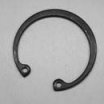

This article's tone or style may not reflect the encyclopedic tone used on Wikipedia.(November 2021) |
A circlip (a portmanteau of "circle" and "clip"), also known as a C-clip, snap ring, or Jesus clip, [1] is a type of fastener or retaining ring that consists of a semi-flexible metal ring with open ends that can be snapped into place into a machined groove on a dowel pin or other part to permit rotation but to prevent axial movement. There are two basic types of circlips: internal (fitted into a bore) and external (fitted over a shaft). Circlips are used to secure pinned connections.




